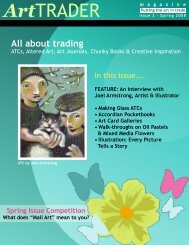Beginner's - ArtTrader Magazine
Beginner's - ArtTrader Magazine
Beginner's - ArtTrader Magazine
Create successful ePaper yourself
Turn your PDF publications into a flip-book with our unique Google optimized e-Paper software.
Art TRADER<br />
m a g a z i n e<br />
My rubber stamps take up much less room in my new studio than<br />
before—I removed all mounted stamps from their wood blocks,<br />
and all of them are organized and stored in empty CD cases in a<br />
single drawer now. They’re easier to find, and I find I use them a<br />
lot more often now that I don’t have to dig through several storage<br />
bins to find the image I want.<br />
In addition to what hides away in drawers and the cupboard, a<br />
lot of my art supplies are on display in the main living area of our<br />
home. I’ve worked slowly since the move to replace many of my<br />
plastic storage bins with vintage jars and tins that have more visual<br />
appeal. Many of these pieces seem to have their own stories, which<br />
I cherish. My favorite piece is a painted lard bucket that holds my<br />
alcohol inks. I also collect old coffee and tea tins—these have been<br />
collected from thrift shops and charity shops, mostly, but I have<br />
found inexpensive containers at antique malls, too.<br />
I regularly make the rounds at local thrift shops, usually browsing<br />
the aisles at my favorite stores once a week. I have found everything<br />
from an unused packet of transparencies to old Scrabble games<br />
to antique cabinet cards and vintage German glass beads. I am<br />
always looking to add to my art supplies and components of future<br />
mixed-media works, and I am paranoid that the week I don’t go to<br />
the Salvation Army shop will be the week that they have something<br />
amazing that I cannot live without owning. It takes a little time, but<br />
I am rewarded over and over again.<br />
Part Two: Creating a Card in My Workspace<br />
To walk through making an ATC in this space, I thought I’d make a<br />
set of cards.<br />
I begin all my cards the same way; I cut recycled chipboard to size,<br />
then cover it with a random layer of scrapbook paper. This is just<br />
a base paper—and sometimes very little of it shows through in the<br />
finished card. I use a Darice glue runner to adhere the paper in<br />
almost all my projects, because the refills are inexpensive, and I<br />
can buy them easily at any craft store.<br />
On top of the first full layer of scrapbook paper, I add one or two<br />
torn strips of a different printed paper, again with the glue runner.<br />
I don’t really worry about matching the papers—everything always<br />
works out, and it’s usually the mismatched papers that make my<br />
best cards. These torn layers add some visual interest and texture<br />
to the card; I like to have something going on behind the card’s<br />
focal image—torn papers are an easy way to achieve that.<br />
5<br />
-33-




